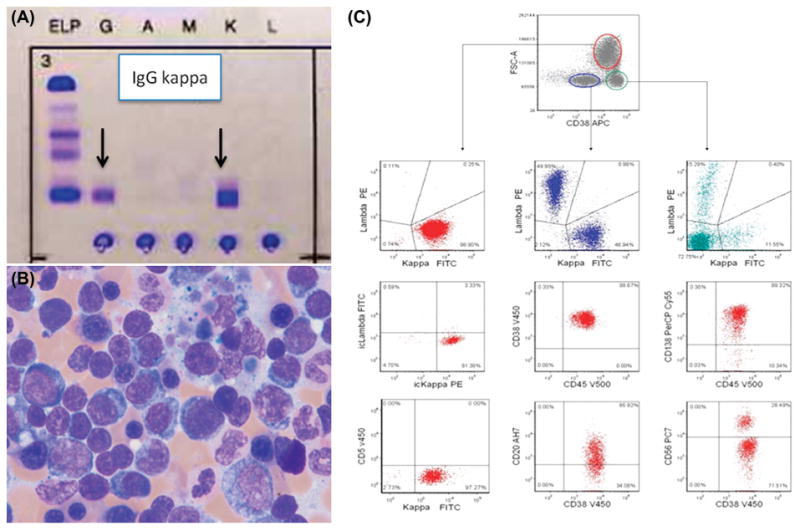Recently, Varettoni et al. reviewed the prevalence and clinical significance of the MYD88 L265P somatic mutation in 58 cases of immunoglobulin M (IgM) secreting lymphoplasmacytic lymphoma (LPL)/Waldenström macroglobulinemia (WM) and 213 cases of related lymphoid neoplasms [1]. Previously, Treon et al. reported two IgG-LPL and one IgA-LPL cases to be MYD88 L265P positive and suggested that MYD88 L265P may be a marker of LPL independent of isotype [2].
In June 2012, we enrolled (NCT01109407) an 82-year-old Hispanic woman recently diagnosed with IgG kappa monoclonal gammopathy of undetermined significance (MGUS) during routine medical follow-up. She reported mild fatigue and weight gain over the past year and denied a history of drenching night sweats, bony aches or fever. Serum protein electrophoresis and immunofixation confirmed IgG kappa monoclonal protein of 2.3 g/dL [Figure 1(A)]. The serum free light-chain (FLC) ratio was 215 (reference interval 0.38-1.78). A skeletal survey was negative for bone lytic lesions. Bone marrow biopsy showed a hypercellular marrow with numerous plasmacytoid lymphocytes present on the smear [Figure 1(B)]. Flow cytometry of the marrow aspirate identified a CD38 + monoclonal population (kappa-restricted) expressing CD19, CD138, CD45, dim CD20, CD27 and partial CD56, but negative for CD5 and CD28, in a background of polyclonal B-cells and B-cell precursors [Figure 1(C)]. Metaphase cytogenetics revealed a normal karyotype, 46,XX. A computed tomography scan of the chest, abdomen and pelvis showed no evidence of lymphadenopathy or splenomegaly. Given these findings, related lymphoid neoplasms (marginal zone lymphoma/chronic lymphocytic leukemia) were less likely, and the patient was given the diagnosis of smoldering IgG LPL. As per clinical guidelines, active surveillance was recommended [3].
Figure 1.

(A) Serum immunofixation. (B) Bone marrow aspirate smear showing numerous lymphoplasmacytic cells. (C) Bone marrow aspirate flow cytometry analysis showing a CD38 + population (red), comprising larger than normal lymphocytes, that expresses CD19, CD138, CD45, dim CD20, CD27 and partial CD56, but is negative for CD5 and CD28. This population comprises 30% of the B-cells and is kappa immunoglobulin light chain-restricted (both surface and intracytoplasmic), most likely representing the plasmacytoid lymphocytes observed in the smear. Additionally, polyclonal B-cells (blue) and precursor B-cells (green) are present. FITC, fluorescein isothiocyanate; PE, phycoerythrin; PerCP, peridinin-chlorophyll-protein complex; APC, allophycocyanin; ic, intracytoplasmic.
In patients with lower tumor burden, allele-specific polymerase chain reaction assays are more sensitive for the detection of MYD88 L265P compared to whole-genome and/or Sanger sequencing [4]. However, since our patient had high amounts of clonal cells present, Sanger sequencing to assess the status of MYD88 L265P was adequate. We extracted DNA from CD138 + bone marrow aspirate cells and performed Sanger sequencing, as previously described [5]. We did not find evidence of MYD88 L265P mutation. Given that the mutation, when present, is always heterogeneous, our findings were interpreted as a true negative.
Recently, we reported on the MYD88 L265P status of nine patients with IgM MGUS [6]; five expressed MYD88 L265P and all had both clonal plasma cells and clonal lymphocytes in the bone marrow, suggesting a precursor state for WM, while negative MYD88 L265P cases had either clonal plasma cells or clonal lymphocytes in the bone marrow. Our (L.M.S.) functional studies on MYD88 in related B-cell malignancies suggest that this gene plays a role in nuclear factor κB (nf-κB) activation, Janus kinase/signal transducer and activator of transcription 3 (JAK/STAT3) signaling and interferon-β production [4].
In summary, our present findings of a negative MYD88 L265P in a patient with non-IgM LPL support the hypothesis that there is heterogeneity in non-IgM LPL pathogenesis, of relevance for diagnosis, and of potential importance for treatment and prognosis. Larger case series are needed to confirm this result and to determine the role of MYD88 in non-IgM LPL.
Footnotes
Potential conflict of interest: Disclosure forms provided by the authors are available with the full text of this article at www.informahealthcare.com/lal.
References
- 1.Varettoni M, Arcaini L, Zibellini S, et al. Prevalence and clinical significance of the MYD88 (L265P) somatic mutation in Waldenstrom's macroglobulinemia and related lymphoid neoplasms. Blood. 2013;121:2522–2528. doi: 10.1182/blood-2012-09-457101. [DOI] [PubMed] [Google Scholar]
- 2.Treon SP, Xu L, Yang G, et al. MYD88 L265P somatic mutation in Waldenstrom's macroglobulinemia. N Engl J Med. 2012;367:826–833. doi: 10.1056/NEJMoa1200710. [DOI] [PubMed] [Google Scholar]
- 3.Korde N, Kristinsson SY, Landgren O. Monoclonal gammopathy of undetermined significance (MGUS) and smoldering multiple myeloma (SMM): novel biological insights and development of early treatment strategies. Blood. 2011;117:5573–5581. doi: 10.1182/blood-2011-01-270140. [DOI] [PMC free article] [PubMed] [Google Scholar]
- 4.Xu L, Hunter ZR, Yang G, et al. MYD88 L265P in Waldenström macroglobulinemia, immunoglobulin M monoclonal gammopathy, and other B-cell lymphoproliferative disorders using conventional and quantitative allele-specific polymerase chain reaction. Blood. 2013;121:2051–2058. doi: 10.1182/blood-2012-09-454355. [DOI] [PMC free article] [PubMed] [Google Scholar]
- 5.Ngo VN, Young RM, Schmitz R, et al. Oncogenically active MYD88 mutations in human lymphoma. Nature. 2011;470:115–119. doi: 10.1038/nature09671. [DOI] [PMC free article] [PubMed] [Google Scholar]
- 6.Landgren O, Staudt L. MYD88 L265P somatic mutation in IgM MGUS. N Engl J Med. 2012;367:2255–2256. doi: 10.1056/NEJMc1211959. author reply 2256–2257. [DOI] [PubMed] [Google Scholar]


